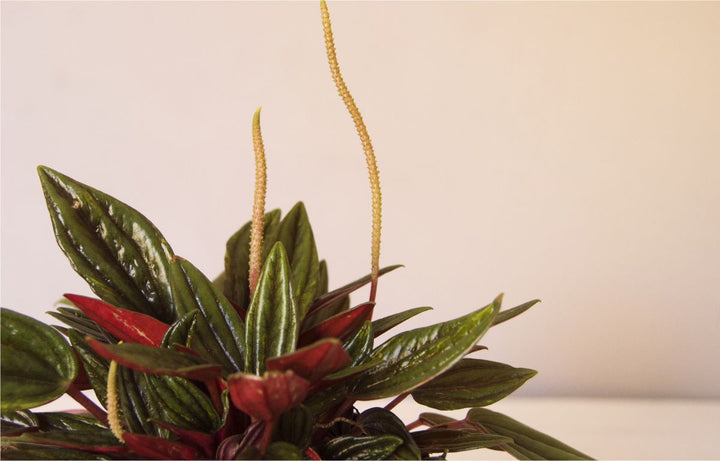
Plant Profile: Radiator Plant, Peperomia Rosso
Plant Profile: Radiator Plant, Peperomia Rosso
The Radiator plant, Peperomia Rosso is native to tropical and subtropical South American regions. It is just one in over 1,000 different species from the genus Peperomia, an offshoot from the larger Piperaceae or pepper family. So called the "Radiator Plant" as its leaves resemble an old-fashioned cast iron radiator and has an unusually high tolerance for warm conditions.

For beginner plant enthusiasts, the Radiator plant is sadly often overlooked for more widely popular smaller plant varieties like Golden Pothos and the Heart Leaf Philodendron. However, this hardy plant can grow as tall as a meter when given the chance and requires very little care to thrive.
Peperomia Rosso variety is not only visually appealing with its crimp texture, contrasting deep red underside and glossy light and dark green vein patterning leaf face, but it also boasts remarkable low-maintenance qualities and provides numerous health and well-being benefits.
- Easy maintenance: The Radiator plant has a very low-maintenance nature, thriving in environments with less frequent watering and tolerating the warmth often found near heat sources.
- Ideal for warm environments: It is often selected for its ability to tolerate warmer indoor environments, similar to the conditions around heating units.
- Improved air quality: The Radiator plant is known for its ability to purify the air by removing toxins such as formaldehyde and benzene.
- Natural humidifiers: It naturally releases moisture into the air, increasing humidity levels and reducing the risk of respiratory problems.
- Stress reduction: The presence of greenery indoors has a calming effect, promoting relaxation and reducing stress levels.
- Enhanced focus and productivity: Studies have shown that having plants in the workspace can improve concentration and productivity.
Growing a Radiator plant, Peperomia Rosso:
- Positioning: Place your Radiator Plant in an area with bright, indirect light. However, avoid exposing it to direct sunlight, as it can scorch the leaves.
- Sunlight: Being native to tropical regions, the Radiator Plant thrives in moderate to bright light conditions. However, it can tolerate lower light levels, making it suitable for indoor environments with limited natural light.
- Soil: Use a well-draining premium potting soil mix that can easily be purchased from most nurseries. You can also make your own mix using garden soil and a good mixture of peat moss and perlite for water retention.
- Humidity: Radiator plants appreciate moderate to higher humidity levels around 40%-60%, but they can still tolerate average indoor humidity which is usually in the 35% range but not lower.
- Temperature: The ideal temperature range is generally between 20C to 28C. However, the Radiator plant can tolerate slightly cooler temperatures, especially during the night-time, but it's essential to avoid exposure to extreme cold or frost.
- Watering: Favouring warm temperatures, it's natural for the moisture in the soil to dry quickly. However, be careful not to overwater the plant in an attempt to compensate as this can lead to root rot. Water your Radiator Plant when the top inch of soil feels dry to the touch. It's better to underwater than to overwater this plant.
- Fertiliser: Feed your radiator plant with a balanced, diluted liquid fertiliser every 4 weeks or so during its active growing season of spring and summer. Avoid fertilizing during the dormant period.
- Pest Management: Keep an eye out for common houseplant pests such as spider mites and mealybugs. Inspect your plant regularly and take prompt action if you spot any infestations.
- Propagation: To propagate a Radiator Plant, take a healthy leaf cutting, allow it to callus for a day, plant it in well-draining soil, provide bright indirect light and humidity, and wait for it to develop roots and new growth.

Problems and Solutions:
- Flowering: When young, the Radiator Plant will focus on producing and growing its foliage. As it matures and if the conditions are perfect it can produce long, and think flowering spikes. These don't harm the plant and can create a point of interest.
- Even growth: Rotate the plant occasionally to ensure even growth and prevent leaning towards the light source.
- Pruning: Regularly remove dead or yellowing leaves to maintain the plant's aesthetics and overall health. Pruning also helps redirect the plant's energy toward new growth.
- Avoid direct sunlight: While the Radiator plant can tolerate warmth, it's important not to subject it to direct sun exposure, as this can lead to leaf scorching.
- Indoor heating units: Although it is called the Radiator plant, do not place your plant where the hot air is blowing directly out of the heating units. This air is usually very dry, and direct exposure can dehydrate and even burn the leaves if set at high temperatures.
- Increase humidity: Although tolerant to heat and low watering, humidity is one thing your Radiator plant can't compromise on. If there is not enough moisture in the air your plant's leaves may turn brittle and dry on the edges and may even fall off. Use a spray bottle or misting water tray to give the air around the plant more moisture. Avoid misting too close to the leaves, as this could lead to water spots or encourage fungal growth.
- Avoid draughty areas: Ensure that the plant is not placed near draughty windows, doors, or air conditioning vents, as sudden drops in temperature can stress the plant and stunt growth.
- Winter warning: During the winter months or if you keep your home cooler, it's a good idea to adjust your care routine. Make sure the plant is away from cold windows and consider reducing watering slightly, as the plant's growth might slow down in cooler conditions.
With its unique foliage and low-maintenance nature, the Radiator Plant provides an ideal balance between durability and beauty, making it an excellent addition to any indoor plant enthusiasts' green family.
You may also enjoy this blog on the Philodendron Rojo Congo
